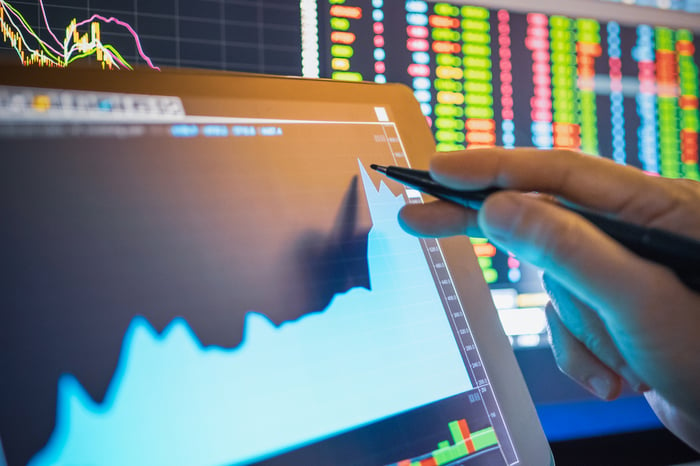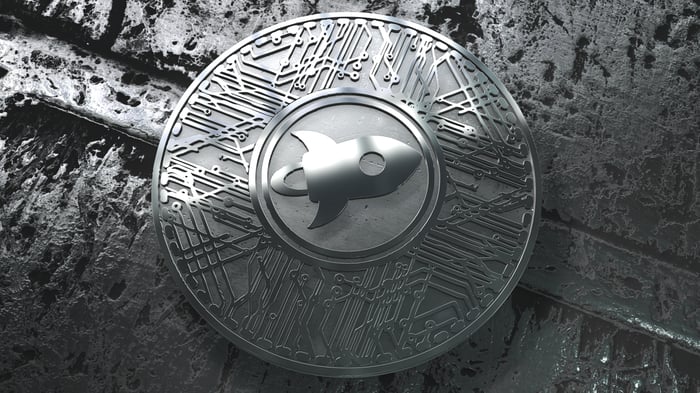It's been a stellar 20-plus months for the cryptocurrency market, even taking into account the crash that occurred late last week. From the pandemic low in March 2020 to Dec. 4, 2021, the aggregate value of digital currencies skyrocketed more than 15-fold to $2.3 trillion.
Although the Big Two -- Bitcoin and Ethereum -- receive much of the credit for these nominal gains, it's meme coins Shiba Inu (SHIB -5.50%) and Dogecoin (DOGE -4.16%) that have come out of nowhere to become fringe top-10 tokens, in terms of market cap.

Shiba Inu-themed coins have fetched massive gains for crypto investors. Image source: Getty Images.
SHIB and DOGE have soared, but both are poised for massive reversions
Shiba Inu is the unquestioned jaw-dropper in 2021. With a token price near $0.000036 as of late evening Dec. 4, Shiba Inu had returned more than 49,000,000% on a year-to-date basis. This means investors who put their money to work in SHIB at midnight on Jan. 1 would now be millionaires for less than the cost of a cup of coffee.
The gains for Dogecoin have also been impressive, albeit not on the same level as Shiba Inu coin. DOGE tokens have gained almost 9,600% since benchmark S&P 500 bottomed out on March 23, 2020. Comparatively, the S&P 500 is up a little over 100%.
While there's been an insatiable amount of hype behind Shiba Inu and Dogecoin, and their respective investor bases strongly believe both coins have a future, history would suggest that they're headed for an epic reversion.
When I examined the performance of payment coins that had gained at least 24,000% in a span of 10 to 30 months, I discovered that they all went on to lose 93% to 99% of their value once they hit their peak. Shiba Inu capped out at a 121,000,000% gain in 2021, whereas Dogecoin was higher by more than 27,000% at one point in a six-month stretch. Even with SHIB and DOGE respectively 59% and 76% below their all-time highs hit in 2021, it's quite clear that both still have a long way to fall.
The icing on the cake is that neither meme coin offers anything resembling a competitive advantage or widespread utility. With tens of thousands of blockchain projects in some stage of development, there's simply nothing about either coin to suggest they'll be long-term winners.

Image source: Getty Images.
This crypto duo can surpass Shiba Inu and Dogecoin in 2022
But as Shiba Inu and Dogecoin lose their luster, other coins with real-world potential are set to hurdle them and potentially take their place as top-10 or fringe top-10 tokens. Here are two digital currencies that could realistically end 2022 with larger market caps than SHIB and DOGE.
Algorand
The first cryptocurrency that can leapfrog both ultra-popular meme coins is Algorand (ALGO 12.12%). To offer some idea of where things currently stand, Dogecoin has a $23.2 billion market cap, Shiba Inu chimes in at $19.9 billion, and Algorand is toting around a $10.2 billion market value.
With more than 15,000 listed cryptocurrencies on CoinMarketCap.com, differentiation, competitive edge, and real-world potential are what will separate the winners from a sea of short-term hype. In Algorand's case, it has three important factors that should allow it to be a long-term success.
To begin with, its unique blockchain consensus mechanism is an improvement over traditional proof of stake. This mechanism, known as pure proof of stake, randomly and secretly chooses small groups of ALGO hodlers to vote on proposals and propose blocks. With this randomization in place, Algorand's developers have effectively eliminated the possibility of small groups of hodlers disrupting the network.
Secondly, Algorand is fast. A quick check of its key metrics as of this past weekend revealed a transactional finality of 4.39 seconds and the ability to process 1,152 transactions per second (TPS). Compare this to Shiba Inu, an ERC-20 token built on the Ethereum blockchain, which is limited to 13 TPS and takes about six minutes to complete a transaction.
But the third and most important aspect of Algorand is the developers' focus on blockchain interoperability. With a lot of businesses developing unique blockchain, there's the real possibility they won't work with each other. Algorand is developing solutions that'll allow differing blockchain technology to mesh. This makes Algorand a good bet to be a hit with the business world.

Image source: Getty Images.
Stellar
The furthest away of this duo, based solely on market cap, is Stellar (XLM -1.13%). As of this past weekend, Stellar's market value was $6.9 billion, placing it 27th on the list of the world's largest digital currencies.
Stellar represents everything good about the development of financially focused blockchain technology. With existing payment infrastructure, it can take up to a week for a cross-border payment to validate and settle. With Stellar, fiat currency is converted to the protocol token of the Stellar blockchain, XLM (known as the Lumen), transferred to its destination, and converted back to the fiat of choice. This process can be completed in an average of four to five seconds.
Something else that gives Stellar an advantage over the vast majority of its payment network competition is the cost to complete these transactions. Sending money from Point A to B with Stellar costs 0.00001 Lumen. With Lumens trading hands at $0.28 over the weekend, the actual cost of a cross-border transaction is just $0.0000028. Put another way, it would take around 357,000 transactions before users even racked up $1 in fees. Compare that to the wire fees financial institutions can charge for cross-border payments and you'll quickly realize the advantage Stellar's financially focused blockchain brings to the table.
The exceptional speed and low cost of Stellar's blockchain has already led to some intriguing real-world partnerships. This includes working with IBM and a dozen banks in the South Pacific region to test cross-border payments four years ago. It also led Tala and Visa to partner with Stellar in an effort to expand financial blockchain solutions to emerging markets.
Stellar and Algorand may not offer the social media hype of Dogecoin or Shiba Inu, but they're two projects with a clear path to real-world relevance.





